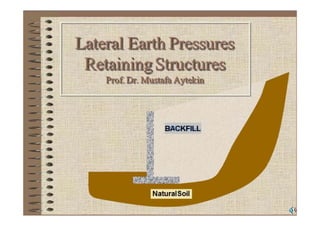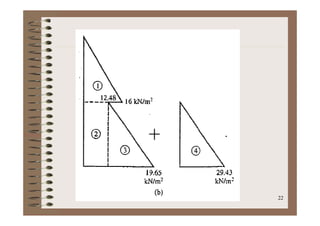Lect 14 lateral_earthpressures
- 1. Lateral Earth Pressures Structures Retaining Prof. Dr. Mustafa Aytekin
- 2. SIVA Copyright┬®2001 Lateral Support In geotechnical engineering, it is often necessary to prevent lateral soil movements. Tie rod Anchor Sheet pile Cantilever Braced excavation Anchored sheet pile 2 retaining wall
- 3. SIVA Copyright┬®2001 Lateral Support We have to estimate the lateral soil pressures acting on these structures, to be able to design them. S il Soil ili nailing Gravity Retaining Reinforced earth wall 3 wall
- 4. SIVA Copyright┬®2001 Soil Nailing 4
- 5. SIVA Copyright┬®2001 Sheet Pile Sheet piles marked for driving 5
- 6. SIVA Copyright┬®2001 Sheet Pile Sheet pile wall 6
- 7. SIVA Copyright┬®2001 Sheet Pile During installation Sheet pile wall 7
- 8. SIVA Copyright┬®2001 Lateral Support Reinforced earth walls are increasingly becoming popular. geosynthetics 8
- 9. SIVA Copyright┬®2001 Lateral Support filled with Crib walls have been used in Queensland. soil Good drainage & allow plant growth. Interlocking stretchers and Looks good. headers 9
- 10. SIVA Copyright┬®2001 Earth Pressure at Rest GL In a homogeneous natural soil deposit, ’ü│vŌĆÖ ’ü│hŌĆÖ X the ratio ’ü│hŌĆÖ/’ü│vŌĆÖ is a constant known as coefficient of earth pressure at rest (K0). Importantly, at K0 state, there are no lateral strains. 10
- 11. SIVA Copyright┬®2001 Estimating K0 For normally consolidated clays and granular soils, K0 = 1 ŌĆō sin ’ü”ŌĆÖ For overconsolidated clays, K0,overconsolidated = K0,normally consolidated OCR0.5 From elastic analysis, ’üĄ K PoissonŌĆÖs ’ĆĮ Poisson s 0 1 ’ĆŁ’üĄ ratio 11
- 12. SIVA Copyright┬®2001 Active/Passive Earth Pressures - in granular soils Wall moves away from soil Wall moves A towards soil wall B smooth LetŌĆÖs look at the soil elements A and B during the wall movement. 12
- 13. SIVA Copyright┬®2001 Active Earth Pressure - in granular soils ’ü│vŌĆÖ= ’ü¦z Initially there is no lateral movement ’ü│vŌĆÖ A ’ü│hŌĆÖ z Initially, movement. ’ü£’ü│hŌĆÖ = K0 ’ü│vŌĆÖ = K0 ’ü¦z As the wall moves away from the soil, ’ü│vŌĆÖ remains the same; and ’ü│hŌĆÖ decreases till failure occurs. Active state 13
- 14. SIVA Copyright┬®2001 Active Earth Pressure - in granular soils ’ü┤ As the wall moves away from the soil, Initially (K0 state) Failure (Active state) ’ü│vŌĆÖ ’ü│ decreasing ’ü│hŌĆÖ active earth pressure 14 p
- 15. SIVA Copyright┬®2001 Active Earth Pressure - in granular soils ’ü┤ ’ü” WJM Rankine (1820-1872) [’ü│hŌĆÖ]active ’ü│vŌĆÖ ’ü│ [’ü│ ' ] ’ĆĮ K ’ü│ ' h active A v 1 ’ĆŁ sin ’ü” 2 RankineŌĆÖs coefficient of pressure ’ĆĮ A K active earth 15 tan (45 / 2) 1 sin ’ü” ’ü” ’ĆĮ ’ĆŁ ’Ć½
- 16. SIVA Copyright┬®2001 Active Earth Pressure - in granular soils ’ü┤ ’ü│vŌĆÖ ŌĆÖ Failure plane is at 45 + ’ü”/2 to horizontal ’ü│hŌĆÖ A 45 + ’ü¬/2 ’ü” 90+’ü¬ [’ü│hŌĆÖ]active ’ü│vŌĆÖ ’ü│ 16
- 17. SIVA Copyright┬®2001 Active Earth Pressure - in granular soils As the wall moves away from the soil, ’ü│hŌĆÖ decreases till failure occurs. ’ü│hŌĆÖ K state ’ü│vŌĆÖ A ’ü│hŌĆÖ z h Active state K0 h wall movement 17
- 18. SIVA Copyright┬®2001 Active Earth Pressure - in cohesive soils Follow the same steps as for granular soils. Only difference is that c ’é╣ 0. [ ' ] K ' 2 K h active A v A ’ü│ ’ĆĮ ’ü│ ’ĆŁ2c Everything else the same for soils 18 as granular soils.
- 19. SIVA Copyright┬®2001 Example 19
- 24. SIVA Copyright┬®2001 What is the excavation depth without a support 24
- 25. SIVA Copyright┬®2001 h active A v A [’ü│ ' ] ’ĆĮ K ’ü│ '’ĆŁ2c K 25
- 26. SIVA Copyright┬®2001 Solved in the classroom 26
- 31. SIVA Copyright┬®2001 Passive Earth Pressure - in granular soils Initially, soil is in K0 state. As the wall moves towards the soil, ’ü│ ŌĆÖ remains the same and ’ü│vŌĆÖ B ’ü│hŌĆÖ v same, ’ü│hŌĆÖ increases till failure occurs. h Passive state 31
- 32. SIVA Copyright┬®2001 Passive Earth Pressure - in granular soils ’ü┤ As the wall moves towards the soil, Initially (K0 state) Failure (Active state) passive earth pressure ’ü│vŌĆÖ ’ü│ increasing ’ü│ ŌĆÖ 32 h
- 33. SIVA Copyright┬®2001 Passive Earth Pressure - in granular soils ’ü┤ ’ü” ’ü│vŌĆÖ [’ü│hŌĆÖ]passive ’ü│ [’ü│ ' ] ’ĆĮ K ’ü│ ' h passive P v 1 ’Ć½ sin ’ü” 2 RankineŌĆÖs coefficient of passive ’ĆĮ P K earth pressure 33 tan (45 / 2) 1 sin ’ü” ’ü” ’ĆĮ ’Ć½ ’ĆŁ
- 34. SIVA Copyright┬®2001 Passive Earth Pressure - in granular soils ’ü┤ ’ü│vŌĆÖ ŌĆÖ Failure plane is at 45 - ’ü”/2 to horizontal 45 - ’ü¬/2 ’ü│hŌĆÖ A ’ü” 90+’ü¬ ’ü│vŌĆÖ [’ü│hŌĆÖ]passive ’ü│ 34
- 35. SIVA Copyright┬®2001 Passive Earth Pressure - in granular soils As the wall moves towards the soil, ’ü│hŌĆÖ increases till failure occurs. ’ü│hŌĆÖ ’ü│vŌĆÖ B ’ü│hŌĆÖ h Passive state h K0 state wall movement 35
- 36. SIVA Copyright┬®2001 Passive Earth Pressure - in cohesive soils Follow the same steps as for granular soils. Only difference is that c ’é╣ 0. [ ' ] K '’Ć½2 K h passive P v P ’ü│ ’ĆĮ ’ü│ 2c Everything else the same for soils 36 as granular soils.
- 37. SIVA Copyright┬®2001 Earth Pressure Distribution - in granular soils [’ü│hŌĆÖŌĆÖ]active PA and PP are the resultant active and passive thrusts on the wall [’ü│hŌĆÖ]passive H P 0 5 K H2 h PA=0.5 KA’ü¦PP=0.5 KP’ü¦h2 K 37 KP’ü¦h A’ü¦H
- 38. ’ü│hŌĆÖ Passive state Active state K0 state Wall movement (not to scale)
- 39. SIVA Copyright┬®2001 RankineŌĆÖs Earth Pressure Theory h active A v A [’ü│ ' ] ’ĆĮ K ’ü│ '’ĆŁ2c K h passive P v P [’ü│ ' ] ’ĆĮ K ’ü│ '’Ć½2c K ’ü▒ Assumes smooth wall ’ü▒ Applicable only on vertical walls 39
- 40. SIVA Copyright┬®2001 Retaining Walls - Applications Road Train 40
- 41. SIVA Copyright┬®2001 Retaining Walls - Applications highway 41
- 42. SIVA Copyright┬®2001 Retaining Walls - Applications High-rise building basement wall 42
- 43. SIVA Copyright┬®2001 Gravity Retaining Walls cement mortar l i t cobbles plain concrete or stone masonry They rely on their self weight to support the backfill 43
- 44. SIVA Copyright┬®2001 Cantilever Retaining Walls Reinforced; smaller section than gravity walls They act like vertical cantilever, fixed to the ground 44
- 45. SIVA Copyright┬®2001 Design of Retaining Wall - in granular soils 2 2 1 3 3 Block no. 1 toe toe Wi = weight of block i Analyse the stability of this rigid body with 45 y y g y xi = horizontal distance of centroid of block i from toe vertical walls (’ü£Rankine theory valid)
- 46. Safety against sliding along the base P ’āź {W W}. tan’üż soil-concrete friction P i sliding P A ’Ć½F ’ĆĮ soil angle ’é╗ 0.5 ŌĆō 0.7 ’ü” to be greater 2 2 g than 1.5 1 PA 3 3 PA H PP 1 PP S toe S R h toe y R y PP= 0.5 KP’ü¦h2 PA= 0.5 KA’ü¦H2
- 47. Safety against overturning about toe P P h / 3 ’āź { W i i } overturning P H/3 A x ’Ć½F ’ĆĮ to be greater 2 2 g than 2.0 1 PA 3 3 PA H PP 1 PP S toe S R h toe y R y
- 48. SIVA Copyright┬®2001 Points to Think About How does the key help in improving the stability against sliding? ShouldnŌĆÖt we design retaining walls to resist at-rest (than active) earth pressures since the thrust on the wall is greater in K0 state (K0 > KA)? 48
- 49. SIVA Copyright┬®2001 THE END 49















![SIVA Copyright┬®2001
Active Earth Pressure
- in granular soils
’ü┤
’ü”
WJM Rankine
(1820-1872)
[’ü│hŌĆÖ]active ’ü│vŌĆÖ ’ü│
[’ü│ ' ] ’ĆĮ K ’ü│
' h active A v 1 ’ĆŁ sin ’ü”
2
RankineŌĆÖs coefficient of
pressure
’ĆĮ A K active earth 15 tan (45 / 2)
1 sin
’ü”
’ü”
’ĆĮ ’ĆŁ
’Ć½](https://image.slidesharecdn.com/lect14lateralearthpressures-141125070023-conversion-gate01/85/Lect-14-lateral_earthpressures-15-320.jpg)
![SIVA Copyright┬®2001
Active Earth Pressure
- in granular soils
’ü┤
’ü│vŌĆÖ
ŌĆÖ
Failure plane is at
45 + ’ü”/2 to horizontal
’ü│hŌĆÖ A 45 + ’ü¬/2
’ü” 90+’ü¬
[’ü│hŌĆÖ]active ’ü│vŌĆÖ
’ü│
16](https://image.slidesharecdn.com/lect14lateralearthpressures-141125070023-conversion-gate01/85/Lect-14-lateral_earthpressures-16-320.jpg)

![SIVA Copyright┬®2001
Active Earth Pressure
- in cohesive soils
Follow the same steps as
for granular soils. Only
difference is that c ’é╣ 0.
[ ' ] K ' 2 K
h active A v A ’ü│ ’ĆĮ ’ü│ ’ĆŁ2c Everything else the same
for soils
18
as granular soils.](https://image.slidesharecdn.com/lect14lateralearthpressures-141125070023-conversion-gate01/85/Lect-14-lateral_earthpressures-18-320.jpg)






![SIVA Copyright┬®2001
h active A v A [’ü│ ' ] ’ĆĮ K ’ü│ '’ĆŁ2c K
25](https://image.slidesharecdn.com/lect14lateralearthpressures-141125070023-conversion-gate01/85/Lect-14-lateral_earthpressures-25-320.jpg)







![SIVA Copyright┬®2001
Passive Earth Pressure
- in granular soils
’ü┤
’ü”
’ü│vŌĆÖ [’ü│hŌĆÖ]passive ’ü│
[’ü│ ' ] ’ĆĮ K ’ü│
' h passive P v 1 ’Ć½
sin ’ü”
2
RankineŌĆÖs coefficient of
passive ’ĆĮ P K earth pressure
33 tan (45 / 2)
1 sin
’ü”
’ü”
’ĆĮ ’Ć½
’ĆŁ](https://image.slidesharecdn.com/lect14lateralearthpressures-141125070023-conversion-gate01/85/Lect-14-lateral_earthpressures-33-320.jpg)
![SIVA Copyright┬®2001
Passive Earth Pressure
- in granular soils
’ü┤
’ü│vŌĆÖ
ŌĆÖ
Failure plane is at
45 - ’ü”/2 to horizontal
45 - ’ü¬/2 ’ü│hŌĆÖ A
’ü” 90+’ü¬
’ü│vŌĆÖ [’ü│hŌĆÖ]passive
’ü│
34](https://image.slidesharecdn.com/lect14lateralearthpressures-141125070023-conversion-gate01/85/Lect-14-lateral_earthpressures-34-320.jpg)

![SIVA Copyright┬®2001
Passive Earth Pressure
- in cohesive soils
Follow the same steps as
for granular soils. Only
difference is that c ’é╣ 0.
[ ' ] K '’Ć½2 K
h passive P v P ’ü│ ’ĆĮ ’ü│ 2c Everything else the same
for soils
36
as granular soils.](https://image.slidesharecdn.com/lect14lateralearthpressures-141125070023-conversion-gate01/85/Lect-14-lateral_earthpressures-36-320.jpg)
![SIVA Copyright┬®2001 Earth Pressure Distribution
- in granular soils
[’ü│hŌĆÖŌĆÖ]active
PA and PP are the
resultant active and
passive thrusts on
the wall
[’ü│hŌĆÖ]passive H
P 0 5 K H2
h
PA=0.5 KA’ü¦PP=0.5 KP’ü¦h2
K 37 KP’ü¦h A’ü¦H](https://image.slidesharecdn.com/lect14lateralearthpressures-141125070023-conversion-gate01/85/Lect-14-lateral_earthpressures-37-320.jpg)

![SIVA Copyright┬®2001
RankineŌĆÖs Earth Pressure Theory
h active A v A [’ü│ ' ] ’ĆĮ K ’ü│ '’ĆŁ2c K
h passive P v P [’ü│ ' ] ’ĆĮ K ’ü│ '’Ć½2c K
’ü▒ Assumes smooth wall
’ü▒ Applicable only on vertical walls
39](https://image.slidesharecdn.com/lect14lateralearthpressures-141125070023-conversion-gate01/85/Lect-14-lateral_earthpressures-39-320.jpg)










